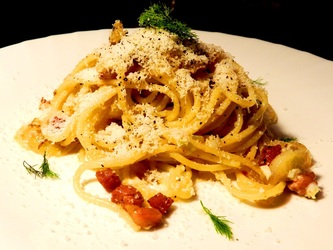
While I've known what real carbonara is even before coming to Italy (hint: no cream!), I didn't really get to fully appreciate the beauty in it's simplicity till I got here and tried to make one for myself (it's a no-brainer really) and it's one of those classic 5-ingredient Italian sauces you can put together in a jiffy for pasta - perfect for the hungry young professional/grad student.
Ingredients:
Pasta, preferably spaghetti (250g makes about 2 servings)
1 Onion (chopped)
100g of Pancetta (or Guanciale, if you can get some)
1-2 Eggs (beaten)
Black Pepper
Pecorino Romano (or Parmigiano-Reggiano, if it's easier to get)
1. Boil water for pasta. Once boiling, add the pasta and cook till al dente (follow the time written in the package only as a guideline - tasting is better). Drain the pasta - to be added to the sauce (which should be finished at more or less the same time the pasta is cooked).
2. While the pasta is cooking, render the fat and crisp up the pancetta in a non-stick pan with a touch of oil or butter (as necessary) at low heat.
3. Raise the heat to medium and add the chopped onion to the pancetta and sweat it out for a bit. Once translucent, lower the heat to low and wait for the pasta to cook.
4. Once the pasta is done, add into the sauce, turn of the heat and add the beaten egg/s and mix thoroughly. The residual heat should be sufficient to slightly cook the egg but it's really this semi-cooked egg that gives the creaminess to the dish.
5. Season the pasta with black pepper, plate it up and shave some pecorino romano on top (be generous!). Garnish with some fresh herbs (parsley rather than basil) if available.
The dish (along with spaghetti all'amatriciana - which has tomato, onion and bacon as basis of the sauce) is a classic Lazio dish (Lazio is the region of the Italian capital city, Rome)... hence, the preference of using Pecorino Romano (sheep's milk cheese) over the more popular (at least abroad) parmesan. The salty cheese should be more than sufficient in adding salt content to the dish. The slightly raw egg provides the natural creaminess to the dish (and to put cream in it was probably started of by the French or the Americans). There are other Italian sauces which may have cream as well as other stuff like peas, mushrooms or broccoli and which probably have been mistaken before as "carbonara" but the original is really just plain and simple. This simplicity is typical of the real peasant fare that Italian food evolved from and it is this understated aspect is what makes Italian food so good for me.
Some notes: pasta dishes in Italy is always cooked to order (with a few exceptions, like pasta al forno - baked pasta) so cook it only when ready to eat it (never make pasta wait). Pasta quality is best while warm, after cooking, and problems really start when you let it wait either in the water (without draining, the pasta will swell too much and become soggy) or on a plate (unsauced, the pasta will dry out and stick together). I think this started these myths of putting oil in the water so the pasta won't stick together, etc. but, really, Italians don't do that. They just cook pasta to order and always al dente and all is well in the world!
 RSS Feed
RSS Feed